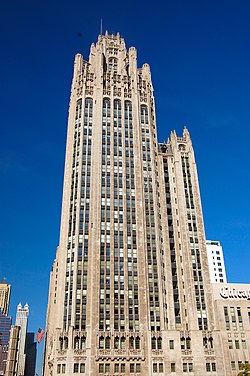자료: http://en.wikipedia.org/wiki/Tribune_Tower
| Tribune Tower | |
| Information | |
|---|---|
| Location | 435 North Michigan Avenue,Chicago, Illinois, USA |
| Status | Complete |
| Constructed | 1923–1925 |
| Use | Office |
| Top floor | 462 feet (141 m) |
| Floor count | 36 |
| Companies | |
| Architect | Howells & Hood—John Mead Howells and Raymond Hood |
The Tribune Tower is a Gothic building located at 435 North Michigan Avenue in Chicago, Illinois. It is the home of the Chicago Tribune and Tribune Company. WGN Radio (720 kHz) also broadcasts from the building, with ground-level studios overlooking nearby Pioneer Court and Michigan Avenue. CNN's Chicago bureau is located in the building. It is listed as a Chicago Landmarkand is a contributing property to the Michigan-Wacker Historic District.
Contents[hide] |
[edit]The Competition
In 1922, the Chicago Tribune hosted an international design competition for its new headquarters, and offered a $50,000 prize for "the most beautiful and eye-catching building in the world". The competition worked brilliantly for months as a publicity stunt, and the resulting entries still reveal a unique turning point in American architectural history. More than 260 entries were received.
The winner was a neo-Gothic design by New York architects John Mead Howells and Raymond Hood, with buttresses near the top.
The entry that many perceived as the best—a radically simplified tower by the Finnish architect Eliel Saarinen—took second place. Saarinen's tower, which anticipated the coming impact of stripped-down modernism on building form, was preferred by critics like Louis Sullivan, and was a strong influence on the next generation of skyscrapers — including Raymond Hood's own subsequent work on the McGraw-Hill Building and Rockefeller Center. The 1929 Gulf Building in Houston, Texas, designed by architects Alfred C. Finn, Kenneth Franzheim, and J. E. R. Carpenter, is a full realization of that Saarinen design. César Pelli's 181 West Madison Street Building in Chicago is also thought to be inspired by Saarinen's design.
Other Tribune tower entries by figures like Walter Gropius, Bertram Goodhue, Bruno Taut, and Adolf Loos remain intriguing suggestions of what might have been, but perhaps not as intriguing as the one surmounted by Rushmore-like head of an American Indian. These entries have been collected in The Chicago Tribune Tower Competition : Skyscraper Design and Cultural Change in the 1920s by Katherine Solomonson and Richard A. Etlin, 2001.
In 1980 a number of architects including Robert A. M. Stern, Stanley Tigerman, and Bruce Abbey jokingly submitted "late entries."[citation needed]
Archival materials regarding the competition and the building are held by the [[Ryerson & cool
[edit]The Building
By 1922 the neo-Gothic skyscraper had become an established design tactic, with the first important so-called "American Perpendicular Style" at Cass Gilbert's Woolworth Building of 1913. This was a late example, perhaps the last important example, and criticized for its perceived historicism. Construction on the actual Tribune Tower was completed in 1925 and reached a height of 462 feet (141 m) above ground. The ornate buttresses surrounding the peak of the tower are especially visible when the tower is lit at night.
As was the case with most of Hood's projects, the sculptures and decorations were executed by the American artist Rene Paul Chambellan. The tower features carved images of Robin Hood (Hood) and a howling dog (Howells) near the main entrance to commemorate the architects.
Prior to the building of the Tribune Tower, correspondents for the Chicago Tribune brought back rocks and bricks from a variety of historically important sites throughout the world at the request of Colonel McCormick. Many of these reliefs have been incorporated into the lowest levels of the building and are labeled with their location of origin. Stones included in the wall are from such sites as the Trondheim Cathedral, Taj Mahal, the Parthenon, Hagia Sophia, Corregidor Island, Palace of Westminster, petrified wood from the Redwood National and State Parks, the Great Pyramid, The Alamo, Notre-Dame, Abraham Lincoln’s Tomb, the Great Wall of China, the Berlin Wall among others. In all, there are 136 fragments in the building. More recently a rock returned from the moon was displayed in a window in the Tribune giftstore (it could not be added to the wall as NASA owns all moon rocks, and it is merely on loan to the Tribune), and a piece of steel recovered from the World Trade Center has been added to the wall. ......







댓글 없음:
댓글 쓰기